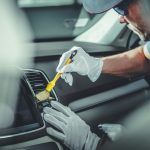Performance Brakes Installation: Enhance Stopping Power with Ease
Comparison with OEM Calipers
OEM calipers provide reliable braking for everyday use but can fall short under stress. Precision-engineered brakes surpass these limitations by offering a tailored approach to brake performance. They often incorporate features like multi-piston configurations, which distribute force more evenly across the brake pads.
This even distribution reduces the likelihood of uneven wear and enhances overall braking efficiency. Compared to OEM calipers, precision-engineered alternatives also utilize advanced materials that handle higher temperatures. This results in longer-lasting performance without warping or degrading.
The precision brake systems provide a significant upgrade for those seeking enhanced stopping power and reliability. While OEM calipers meet basic standards, precision-engineered solutions target specific performance metrics, delivering measurable benefits for enthusiasts and professionals alike.
Optimizing Brakes for Different Uses
Optimizing brakes involves considering the environment where they will be used. Different settings, like city streets or track days, demand specific adjustments to ensure better braking performance and safety.
City Driving and Stop-and-Go Traffic
City driving requires brakes that can handle frequent stops and starts effectively. Brake pads should be designed to withstand heat generated by constant friction. Materials like ceramic or organic pads are popular due to their ability to reduce noise and produce less dust, maintaining clean wheels.
Brake performance in urban settings benefits from rotors that resist warping under repeated use. Ventilated rotors offer enhanced cooling, increasing reliability over long commutes. Maintaining a responsive system with well-maintained brake fluid and regular check-ups ensures drivers face no surprises in fast-paced environments.
Track Days and Performance Driving
For track days and high-performance driving, brakes must endure intense conditions. High-friction brake pads, such as those made from carbon or semi-metallic materials, are essential. These pads provide the necessary grip to handle high speeds, allowing drivers to corner and decelerate with precision.
Rotors used in performance driving should be capable of dissipating heat efficiently. Slotted or drilled rotors help with cooling and prevent fade during sessions. Investing in braided steel brake lines can improve pedal feel, reducing squishiness and ensuring consistent pressure during laps. Regular inspection and timely replacement of components maintain optimal performance on the track, keeping drivers confident and competitive.
Brake System Burnishing and Bedding-in
Burnishing and bedding-in are crucial steps in optimizing brake performance. This process ensures that the new brake components perform efficiently. It involves carefully controlled procedures to align the brake pads and rotors.
Burnishing helps in achieving superior stopping power by gradually heating the brakes. It allows a transfer layer to form between the pad and the rotor, which is essential for effective braking. This layer enhances friction and minimizes wear, thereby improving overall performance.
Bedding-in typically requires a series of controlled stops. These stops help distribute the heat evenly across the brake components. Drivers may begin with gentle applications and gradually increase pressure.
Each vehicle might require tailored procedures for effective results. By meticulously following specific burnishing guidelines, the benefits can be maximized. Properly burnished brakes offer improved safety and comfort during driving.
Different manufacturers may have varied recommendations. Thus, adhering to the specific instructions provided for the brake setup is essential. Regular maintenance and inspection should also complement the bedding-in process for optimal results.



